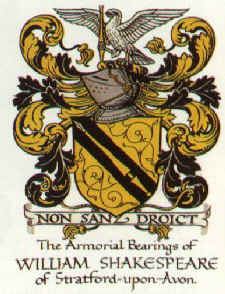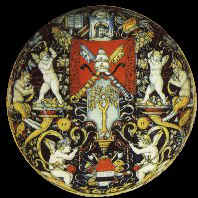|
| |
 Home >>
Heraldry >> Blazoning
Home >>
Heraldry >> Blazoning
         
The rules of blazon
 Blazon
arranges its six tinctures in two main groups - metals and colors. (There is
also a third group, furs: Ermine and Vair.) It places Argent and Or in the
first, Gules, Sable, Azure and Vert in the second. Blazon
arranges its six tinctures in two main groups - metals and colors. (There is
also a third group, furs: Ermine and Vair.) It places Argent and Or in the
first, Gules, Sable, Azure and Vert in the second.
The basic rule is that a color may not be placed on a color or a metal on a
metal. To take the case of a shield depicting a lion: if the field of this
shield is Gules (red), the lion may be Argent (silver/white), Or (gold/yellow)
but
not Azure (blue), Sable (black) or Vert (greenj because Azure, Sable and Vert
belong to the same group as Gules. Conversely, if the field of the shield is
Argent; the lion can be Gules, Azure, Sable or Vert, but not Or. These
fundamental rules have existed since the origin of arms and have almost always
been respected - it is rare to find one per cent of infringements in a given
body of arms. It is assumed that this rule was borrowed from banners and their
insignia, which had a considerable influence on early arms, and was primarily a
question of visibility. The first arms, which all had two tinctures, were
designed as visual signs made to be seen from afar and immediately identifiable
in battle. In fact red is easier to distinguish when placed against white or
yellow than against blue, black or green.
But these questions of visibility do not fully explain these rules. They also
date back to the very rich symbolism of tinctures during the feudal period, a
symbolism that was undergoing major changes at the time. For the new social
order that was becoming established in the West after the millennium was
accompanied by a new system of tinctures: white, red and black were no longer
the only basic tinctures as was often the case in classical antiquity and the
late Middle Ages; blue, green and yellow were now promoted to the same rank, in
social life as in all the codes relating to it. The emergent science of heraldry
was one of these codes.
 Whatever
their origin, over the centuries these rules on the use of tinctures governed
all the arms that were created. However, they were often infringed when two or
more different arms were combined (or marshaled) within one shield and two
tinctures that should in principle not touch each other necessarily became
adjacent. When Edward III proclaimed himself King of France in 1337, he combined
the arms of the two kingdoms on the same shield. In the new shield created by
`quartering', the Azure field of the arms of France necessarily touched the
Gules field of the arms of England. Whatever
their origin, over the centuries these rules on the use of tinctures governed
all the arms that were created. However, they were often infringed when two or
more different arms were combined (or marshaled) within one shield and two
tinctures that should in principle not touch each other necessarily became
adjacent. When Edward III proclaimed himself King of France in 1337, he combined
the arms of the two kingdoms on the same shield. In the new shield created by
`quartering', the Azure field of the arms of France necessarily touched the
Gules field of the arms of England.
 |
|
Beasts of Charge |
|
 |
| |

|